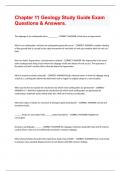Exam (elaborations)
Chapter 11 Geology Study Guide Exam Questions & Answers.
- Course
- Institution
Chapter 11 Geology Study Guide Exam Questions & Answers. The slippage of an earthquake starts ________. - CORRECT ANSWER at the focus or hypocenter What is an earthquake, and how do earthquakes generally occur? - CORRECT ANSWER a sudden shaking of the ground that is caused by the rapid move...
[Show more]



